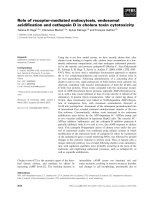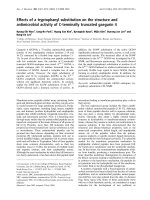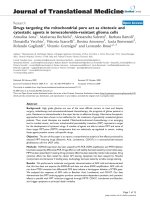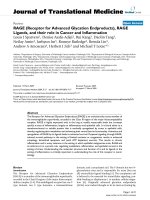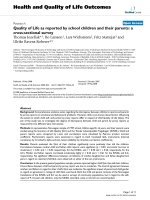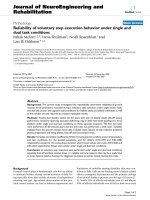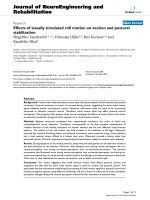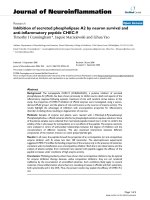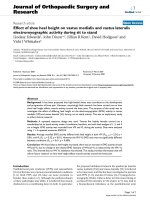Báo cáo hóa học: " Preparation of Pt Ag alloy nanoisland/graphene hybrid composites and its high stability and catalytic activity in methanol electro-oxidation" potx
Bạn đang xem bản rút gọn của tài liệu. Xem và tải ngay bản đầy đủ của tài liệu tại đây (1.58 MB, 10 trang )
NANO EXPRESS Open Access
Preparation of Pt Ag alloy nanoisland/graphene
hybrid composites and its high stability and
catalytic activity in methanol electro-oxidation
Lili Feng, Guo Gao, Peng Huang, Xiansong Wang, Chunlei Zhang, Jiali Zhang, Shouwu Guo and Daxiang Cui
*
Abstract
In this article, PtAg alloy nanoislands/graphene hybrid composites were prepared based on the self-organization of
Au@PtAg nanorods on graphene sheets. Graphite oxides (GO) were prepared and separated to individual sheets
using Hummer’s method. Graphene nano-sheets were prepared by chemical reduction with hydrazine. The
prepared PtAg alloy nanomaterial and the hybrid composites with graphene were characterized by SEM, TEM, and
zeta potential measurements. It is confirmed that the prepared Au@PtAg alloy nanorods/graphene hybrid
composites own good catalytic function for methanol electro-oxidation by cyclic voltammograms measurements,
and exhibited higher catalytic activity and more stability than pure Au@Pt nanorods and Au@AgPt alloy nanorods.
In conclusion, the prepared PtAg alloy nanoislands/graphene hybrid composites own high stability and catalytic
activity in methanol electro-oxidation, so that it is one kind of high-performance catalyst, and has great potential in
applications such as methanol fuel cells in near future.
Introduction
Graphene, a single -atom-thick sheet of hexagonally
arrayed sp
2
-bonded carbon atoms, has attracted inten-
sive interests in recent years [1], owing to its large speci-
fic surface area, high thermal and electrical
conductivities [2-6], great mechanical strength [7]. The
unique properties of graphene sheets provide applica-
tions in synthesis of nanocomposites [8-10], fabrication
of field-effect transistors [11-13], dye-sensitized solar
cells [14], lithium ion batteries [15,16], and electroche-
mical sensors [17]. Up to date, many methods such as a
scotch tape (peel off) metho d [18], epitaxial growth
[19,20], chemical vapor deposition [21], and reduction
of graphene oxide [22-26] have been used to prepare
individual graphene sheets and to improve the proper-
ties of graphene. Among these methods, chemical
reduction method of graphene oxide is with lowest cost
and large scale to prepare graphene, which attract scien-
tists’ intensive attention, and exhibit great application
prospect.
In the field of electrochemistry, graphene is an excel-
lent substrate to load active nanomaterials for energy
applications due to its high conductivity, large surface
area, f lexibility, and chemical stability. For example, Dai
and colleagues [15] made high-capacity anode material
for lithium ion batteries by gr owing Mn
3
O
4
nanoparti-
cles (NPs) on graphene sheets. Zhang et al. [16] pre-
pared mono-dispersed SnO
2
NPs on both sides of single
layer graphene sheets as anode materials in Li-ion bat-
teries. They found much higher retention of SnO
2
-gra-
phene composite than commercial SnO
2
powder after
50 cycles. Apart from these studies, a lot of efforts had
been paid on metal oxide/graphene hybrid composites
[27].However,sofar,fewreports are closely associated
with the use of graphene-based metal materials as het-
erogeneous catalysts [28-30]. Therefore, to prepare and
study graphene/noble metal, heterogeneous materials
become more and more important.
In the field of catalysis, Pt (and Pd) is intensively
applied in direct methanol fuel cells (DMFCs) [31,32],
because of their high-efficient catalysis function for
methanol dehydrogenation. To improve catalytic proper-
ties of the metal materials, the size and structure of NPs
become more and more important. Pt NPs with several
nanometers in diameter and porous structures own high
* Correspondence:
Key Laboratory for Thin Film and Microfabrication Technology of Ministry of
Education, National Key Laboratory of Micro/Nano Fabrication Technology,
Research Institute of Micro/Nano Science and Technology, Shanghai Jiao
Tong University, Shanghai 200240, P. R. China
Feng et al. Nanoscale Research Letters 2011, 6:551
/>© 2011 Feng et al; licensee Springer. This is an Open Access article distributed under the terms of the Creative Commons Attribution
License ( which permits unrestricted use, distribution, and reproduction in any medium,
provided the original work is properly cited.
catalytic activity because of their enlarged surface area.
In addition, the composition of the catalyst is another
important factor for catalytic activity. For instance, pure
Pt nanostructures are easily poisoned by chemisorbed
CO-like intermediates generated in the course of metha-
nol oxidation, which makes their catalytic performance
decreased quickly. To solve this problem, it is feasible to
prepare bimetallic nanocomposites composed of Pt and
those metals such as Ru, Rh, Pd, and Au [33-37]. Other
metal materials are proposed to provide oxygen-contain-
ing species at relative negative poten tial, which can oxi-
dize CO at Pt sites. Therefore, to prepare alloyed Pt
NPs are very necessary. Wu and colleagues had proved
that PtAg alloy nanoislands on gold nanorods had good
optical responses and electrochemical catalytic activity
[38,39]. However, up to date, graphene-based PtAg alloy
nanoislands as heterogeneous catalysts are not still
investigated well.
In this study, we reported to prepare PtAg alloy
nanoislands/graphene hybrid composites based on the
self-assembly of positively charged gold nanorods and
Au@AgPt alloy nanorods on negatively charged gra-
phene sheets. (Here “ @” was defined as a c ore/shell
structure. Au@AgPt alloy nano rod is a core/shell struc-
ture for Au nanorod as the core and AgPt alloy as the
shell. We use Au@Pt
m
Ag
n
to represent the samples, and
m and n are percentage determined by EDX.) The self-
assembly technology enables loading a lot of Au NRs
and Au@AgPt alloy nanorods on individual graphene
sheets with uniform morphology. It was investigated
that the prepared Au@AgPt alloy nanorods/graphene
hybrid composites were used as a fuel cell electrocatalyst
for methanol electro-oxidation. The utilization ratio of
Pt was 23.4%, but its catalytic activity was 124 mA mg
Pt
-1
, which was close to 162.5 mA mg Pt
-1
(99.2% utili-
zation ratio of Pt) reported previously [40]. In addition,
Pt material has also good catalytic stabilization, which
shows that catalytic activity may increase with the utili-
zation ratio of Pt increase, further investigation will b e
helpful to clarify its potential mechanism.
Experimental section
Chemicals
10000 mesh (dimension: 1.5µm) graphite, etyltrimethy-
lammonium bromide (CTAB), PVP (K 30, Mw = 30000-
40000) were obtained from Alfa Company and used as-
received. Sodium borohydride (NaBH
4
), chlorauric acid
(HAuCl
4
·3H
2
O), silver nit rate (AgNO
3
), and potassium
tetrachloroplatinate(II) (K
2
PtCl
4
), L-ascorbic acid (AA),
methanol, sulfuric acid, potassium permanganate
(KMnO
4
), hydrogenperoxide (H
2
O
2
), sodium nitrate
(NaNO
3
), were purchased from Shanghai Sigma Com-
pany and used as-received. Milli-Q water (18 MΩ cm)
was used for all solution preparations. All glassware
used in the following procedures were cleaned in a bath
of a piranha solution (H
2
SO
4
/30%H
2
O
2
=7:3v/v)and
boiling for 30 min.
Synthesis
Synthesis of graphene nanosheets
Graphene oxides (GO) were synthesized from flake gra-
phite (1.5 µm graphite) using modified Hummer’ s
method [41,42]. Then graphite oxides were exfoliated by
ultrasonication for more than 5 h. Well-dispersed
homogeneous graphene oxide solution (0.5 mg mL
-1
)
was obtained. PVP was used to prevent flocculation
when reduced graphene oxide to gra phene sheets. In a
typical procedure for chemical conversion of g raphene
oxide to graphene (GN), 100 mL 8 mg mL
-1
PVP solu-
tion was added to 50 mL 0.5 mg mL
-1
GO solution,
then stirred vigorously for more than 12 h. Afterward,
1.75 mL 0.5% hydrazine solution and 2 mL 2.5% ammo-
nia solution w ere added. The mixture was stirred for 1
h at 95°C. After that, graphene was cooled at room tem-
perature. The whole reduction process was repeated
once more to reduce GO further. The stable black dis-
persion of GN was filtered under the condition of
vacuum with 200 nm membrane as filter paper to col-
lect it, at the same time it was washed with Milli-Q
wat er (18 MΩ cm). Finally, the prepared GNs were dis-
solved in 50 mL water (0.5 mg mL
-1
).
Growth of Au@AgPt nanorods
Au@AgPt nanorods were prepared using an etching
method described by Wu [38]. The specific process is
consisted of four steps: (1) Au nanorods synthesis; (2)
precoat a thin Pt layer on Au nanorod [43]; (3) grow Ag
shell on Au@Pt NRs; and (4) etch Ag shell with Pt (II)
ions.
Hybrid of graphene and Au nanorods
A certain v olume of 0.5 mg mL
-1
GNs was added to 1
mL of the gold nanor ods solution (0.5 mmol L
-1
)or
Au@AgPt nanorods solution. The mixture solution was
then shaken vigorously and sonicated for 30 s. After-
ward, the mixture was left undisturbed and aged at
room temperat ure for more than 24 h. The color of the
solution changed from red (Au nanorods) or dark gray
(Au@AgPt nanorods) to colorless, and the hybrid com-
posites precipitated at the b ottom of the vessel. After-
ward, the precipitate was collected by centrifugation
(12000 rpm for 5 min). Finally, the precipitate was redis-
persed in 100 µL water for electrochemical testing.
Characterizations
UV-Vis-NIR absorption spectra were obtained from a
Varian Cary 50 spectrophotometer. Scanning electron
microscopy (SEM) images and energy dispersive X-ray
(EDX) analysis were taken on a field emission scanning
electron microscope (FESEM, Zeiss Ultra). Transmission
Feng et al. Nanoscale Research Letters 2011, 6:551
/>Page 2 of 10
electron microscopy ( TEM) images were captured on a
JEM-2010/INCA OXFORD at an accelerating voltage of
200 kV. Zeta potential results were carried out on zeta
pot ential/particle sizer (Nicom 380ZLS). CHI660C elec-
trochemical workstation (Chenhua, Shanghai) was car-
ried out for the electrochemical measurement. Cyclic
voltammetry was performed in a three-electrode glass
cell at room temperature. Glassy carbon (GC) electrode
was used as working electrode. Before testing, the elec-
trode was rejuvenated by polished with 0.3 and 0.05 µm
alumina powders, respectively, then sonicated sequen-
tially in alcohol, pure water in each for about 20 min. 5
μL as-prepared samples were drop-cast ed onto GC elec-
trodes, and dried overnight in vacuum conditions. A
platinum wire and an Ag/AgCl (saturated KCl) electrode
were used as counter electrode and r eference electrode,
respectively. The electrolyte solution was purged with
high-purity nitrogen for 30 min and protected under
nitrogen during the measurements. Methanol was elec-
tro-oxidized in an electrolyte containing 0.5 mol L
-1
H
2
SO
4
and 2 mol L
-1
CH
3
OH in the potential range of
-0.25 to 1.0 V at a sweep rate of 50 mV s
-1
.
Results and discussion
Characterization of Pt Ag alloy nanoisland/graphene
hybrid composites
Figure 1 shows the SEM images of graphenes, EDX
spectra of graphene oxide (GO), and graphene. In the
course of graphene preparation, PVP was used and
remarkably increased the stability of graphene sheets
because of strong hydrophobic interactions between gra-
phene sheets and PVP [10]. After reduction, the color of
solution changed from yellow to dark black. Figure 1A
shows that graphene sheets could self-assemble into a
plane on silica wafer without coagulation. The width of
graphene was about 800 nm. GO had an oxygen content
of 43 at om%, as sh own in Figure 1B, the atomic ratio of
carbon to oxygen was 1.24. This result indicated there
was more oxygen content than the empirical formula
C
6
H
2
O
3
proposed by Boehm [44]. After reduction, a
nitrogen peak from PVP appeared in EDX spect ra. Oxy-
gen content in reduced graphene had two sources: one
was from GO, the other one was from PVP. When eval-
uating GO’ s reduction degree, oxygen content came
from PVP should be deducted. After first reduction, the
atomic ratio of carbon to oxygen was 5.2, there was still
30% oxygen content remained (the EDX spectra was not
shown). After second reduction, the atomic ratio of car-
bon to oxygen was 8.9, as shown in Figure 1C, only 14%
oxygen content remained.
Figure 2 shows the TEM images of gold nanorod s (Au
NRs) and Au@AgPt alloy nanorods. Au NRs had a long-
itudinal surface plasmon resonance at 842 nm (see “Fig-
ure S1 in Additional file 1“ ). Both UV-Vis and T EM
image indicate the prepared Au NRs had an aspect ratio
of 4.4. Compared to Au NRs, all the three kinds of Ag-
Pt alloy shell nanorods had rough surfaces. Ag-Pt alloy
shell on the surface of Au NRs looked like nanodots or
nanoislands. The nanoislands structure could increase
surface area of Ag-Pt alloy shells, and improve the
Figure 1 (A), SEM image of graphene, (B), EDX analysis of GO, (C), EDX analysis of graphene. Scale bar in (A) is 800 nm.
Feng et al. Nanoscale Research Letters 2011, 6:551
/>Page 3 of 10
utilization of Pt material. When very few Pt
2+
ions were
used, the nanodots of Ag-Pt alloy particles deposited
almost on the two ends of Au NRs as shown in Figure
2B. With the amount of Pt
2+
ion increased, the nano-
dots of Ag-Pt alloy particles distributed uniformly on
the surface of Au NRs. The amount of Ag and Pt in the
shell layer was determined by EDX spectra. To mention
the samples relatively easily, we used Au@Pt
m
Ag
n
to
represent the samples. Here, m and n were percentage
determined by EDX spectra.
Characterization of Au@PtAg alloy NRs/graphene
hybrid composites was carried out by zeta potential test,
SEM, and TEM. The zeta potential data were shown in
Table 1. GO had a zeta potential of -64.2 mV, which is
attributed t o a l arge number of negatively charged
Figure 2 TEM images of gold nanorods (Au NRs) (A), Au@Pt
0.34
Ag
0.66
NRs (B), Au@Pt
0.57
Ag
0.43
NRs (C), Au@Pt
0.64
Ag
0.36
NRs (D).Scale
bar in (A) is 100 nm, in (B-D) is 50 nm.
Table 1 Average zeta potential measured at 25°C
GO GN Au NRs Au@Pt
0.57
Ag
0.43
NRs
Zeta potential (mV) -64.2 -39.6 30.4 44.8
Feng et al. Nanoscale Research Letters 2011, 6:551
/>Page 4 of 10
functional groups such as carboxyl groups and hydroxyl
groups. Prepared GO solution was good water soluble,
and very stable at ambient condition because of electro-
static repulsion. After reduction, PVP-capped graphene
sheets had a smaller negative zeta potential va lue. The
zeta potential data of Au NRs and Au@PtAg NRs were,
respectively, 30.4 and 44.8 mV, because of double-layer
adsorption of CTAB. The larger value of Au@PtAg NRs
was consistent with more surface area resulted from the
islands structure. In a typical experiment of self-assembly,
the aqueous dispersion of graphene sheets (0.5 mg mL
-1
)
was mixed with Au NRs solution with different weight
ratios (1:1, 1:2, 1:5, 1:10, 1:20, 1:100) and sonicated for 15
min to form a homogeneous mixture. Self-assembly of
positively charged gold nanorods and Au@AgPt alloy
nanorods with negatively charged graphene sheets resulted
in formation of heavier entities; therefore, after 24 h, preci-
pitation could be found at the bottom of the vessel. For
the front four samples (the weight ratio of Au NRs to gra-
phene 1:1, 1:2, 1:5, 1:10), the corresponding supernatants
were colorless. By contrast, the corresponding superna-
tants of the last two samples were still red color which
suggested extensive Au NRs used. As shown in Figure 3A,
3B (weight ratio 1:1 and 2:1), the edges of graphene sheets
were quite clear, as well as Au NRs could spread out uni-
formly on silica wafer with few Au NRs found outside the
graphene sheets; however, Au NRs adsorptive densities
wereverylow.IfaconsiderablequantityofAuNRswas
used, in the case of weight ratio 20:1 and 100:1, redundant
Au NRs could be found outside graphene sheets as
marked by circles in Figure 3E, 3F. Moreover, the edges of
graphene sheets could not be distinguished. When the
weight ratio reached t o 100:1, Au NRs deposited on gra-
phene sheets by means of layer-by-layer, which lead to
illegibility of the edges of graphene sheets. As the results
shown in Figure 3C, 3D, the suitable weight ratio for self-
assemble were 5:1 and 10:1, in which both graphene edges
were clear, and Au NRs distributed uniformly on graphene
sheets. Furthermore, the quantity of Au NRs loaded on
graphene was appropriate.
TEM was also carried out for the sample of weight
ratio 2:1 and 5:1 (see “Figure S2 in Additional file 1“). In
the case of weight ratio 2:1, graphene could easily be
recognized from the fringe and some pleats of graphene
sheets (marked by red arrows). When weight ratio was
5:1, apart from uniformly distributed Au NRs, graphene
sheets could not be seen clearly, which is because it was
quite hard to make a distinction between them and t he
carbon-supported films on the c opper grid due t o the
thin thickness of graphene sheets. SEM and TEM
images both showe d that self-assembly method was
effective in producing homogeneous high-loading nanor-
ods on the surface of graphene. The procedure of pre-
paring graphene/Au@PtAg N Rs hybrids was similar to
that of graphene/Au NRs hybrids except for using
Au@PtAg NRs as precursor for self-assembly. In the fol-
lowing experiment, we used the hybrid composition of
weight ratio 5:1 for methanol electro-oxidation.
Catalytic activity for methanol electro-oxidation
In recent years, DMFCs have intensely been studied
because of their numerous advantages, which include
Figure 3 SEM images of Au NRs/graphene hybrid composites with different weight ratios:1:1(A), 2:1 (B), 5:1 (C), 10:1 (D), 20:1 (E), 100:1
(F). Scale bar: 800 nm.
Feng et al. Nanoscale Research Letters 2011, 6:551
/>Page 5 of 10
high-energy density, the ease of handling a liquid, low
operating temperature, and their possible applications to
micro-fuel cells. Electrocatalytic materials restricted the
performance and a pplication of DMFCs. Herein, cyclic
voltammetry (CV) was carried out to investigate the
electrocatalytic activity of various graphene/Au@PtAg
NRs hybrids materials for the oxidation of methanol.
Three samples of Au@PtAg all oy nanorods and one
sample of Au@Pt n anorods were used to prepare gra-
phene hybrids materials and measured. In the blank
control test, cyclic voltammetry was carried out in 0.5
mol L
-1
H
2
SO
4
solution saturatedwithhigh-purity
nitrogen gas to determine the hydrogen adsorption/des-
orption area between -0.3 and 0.1 V (see “ Figure S3 in
Additional file 1“ ). Hydrogen adsorption/desorption
peak did not appear in CV curveofpuregraphene.It
revealed graphene could not adsorb hydrogen effectively
in this case. As reported, Pt material is good catalyst in
hydrogen adsorption/desorption and methanol electro-
oxidation. The results in “Figure S3 in Additional file 1“
show that all the three samples of Au@PtAg alloy
nanorods graphene hybrids materials and one sample of
Au@Pt nanorods graphene hybrids materials had similar
large hydrogen adsorption/desorption areas denoting
similar effective electrochemical surface areas. Figure 4
shows cyclic voltammetric curves for the methanol
electro-oxidation. For Au@Pt nanorods graphene
hybrids materials (sample b), no obvious o xidation
reduction peak was detected, indicating a poor catalytic
performance for methanol electrooxidation. For the
three samples of Au@PtAg alloy na norods graphene
hybrids materials (sample c,d,ande),methanol-oxida-
tion peaks were clearly observed at about 0.69 V (versus
Ag/AgCl) in the forward sweep and at 0.49 V in the
backward sweep, respectively. The anodic peak current
in the forward sweep was attributed to methanol elec-
trooxidation, in the reverse sweep was attributed to the
remov al of the incompletely oxidized carbonaceous spe-
cies formed in the forward sweep. These carbonaceous
species were mostly in the form of linearly bonded Pt =
C = O, which usually decreased catalytic activities of Pt
materials and the so-called “ catalyst poisoning.” All
PtAg alloy hybrids had good performance than pure Pt
hybrids. The higher activity of PtAg alloy hybrids can be
explained by the bifunctional mechanism [33-37,45]
which was assumed that Ag promotes the oxidation of
the strongly bound CO
ad
on Pt by supplying an oxygen
source (Ag-OH
ad
). Among t he five test samples shown
in Figure 4, the sample graphene/Au@Pt
0.64
Ag
0.36
NRs
had the highest catalytic activity.
To gain more insights into the three catalysts, some
electrochemical parameters such as electrochemically
Figure 4 Cyclic voltammetric curves for the electrooxidation of methanol (sweep rate: 50 mV s
-1
, 0.5 mol L
-1
H
2
SO
4
, 2 mol L
-1
CH
3
OH,
298 K) with the following electrocatalysts. (a) graphene; (b) graphene/Au@Pt NRs; (c) graphene/Au@Pt
0.34
Ag
0.66
NRs; (d) graphene/
Au@Pt
0.57
Ag
0.43
NRs; (e) graphene/Au@Pt
0.64
Ag
0.36
NRs.
Feng et al. Nanoscale Research Letters 2011, 6:551
/>Page 6 of 10
active surfaces (EAS) [40,45], utilization of Pt [40], cata-
lytic activity [40], and the ratio of the forward oxidatio n
current peak (I
f
) to the reverse current peak (I
b
), I
f
/I
b
[46-49] were calculated. EAS parameter provides impor-
tant information regarding the number of available
active sites. The EAS accounts not only for the catalyst
surface available for charge transfer, but also includes
the access of a conductive path to transfer the electrons
to and from the electrode surface. Hydrogen adsorption/
desorption in an electrochemical process is commonly
used to evaluate the EAS. EAS could be obtained
according to Equation 1, in which Q
H
is the charge con-
sumed for the electrooxidation of adsorbed hydrogen;
Q
e
istheelementarychargeorchargeofanelectron;
A
Pt
istheaveragedatomicareaofsurfacePtatoms,
which is 7.69 × 10
-2
nm
2
according to the atomic den-
sity of a Pt surface which is 1.3 × 10
19
m
-2
;andW
Pt
is
the Pt loading at the working electrode. This equation is
based on the well-established hydr ogen-adsorpt ion stoi-
chiometry at a Pt surface (H: Pt = 1:1). Utilization of Pt
was determined by Equation 2. N
t
is Pt atom loading on
the working electrode; N
s
is utilizated Pt atom for elec-
trooxidation [40]. I
f
/I
b
value could be used to evaluate
the catalys t tolerance to the poisoning species. Low I
f
/I
b
value indicates poor oxidation of methanol to carbon
dioxide during the anodic sweep and excessive accumu-
lation of carbonaceous residues on the catalyst surface.
High I
f
/I
b
value shows the converse case.
EAS =
Q
H
Q
e
A
Pt
W
Pt
=
A
Pt
Q
e
×
Q
H
W
Pt
(1)
U
pt
=
N
s
N
t
=
N
H
N
t
(2)
Electrochemical parameters (EAS, Pt utilization, cata-
lytic activity, and I
f
/I
b
) of the three graphene/Au@PtAg
NRs hybrids materials (sample c,d,e in Figure 4) were
listed in Table 2. EAS and Pt utilization of the three gra-
phene/Au@PtAg NRs hybrids catalysts were similar to
that reported in previous reference listed in the fifth
row. They showed much lower EAS and Pt utilization
than that listed in the sixth row whic h reached nearly
100% Pt utilization. Interestingly, graphene/Au@P-
t
0.64
Ag
0.36
NRs (sample e) had high catalytic activity
reached 124 mA mg Pt
-1
, which was just a bit lower
than the s ample of 99% Pt utilization in the sixth row.
This result suggested graphene could enhance catalytic
activity of Pt material. As Pt utilization was not high for
our three samples tested in the experiment, if Pt utiliza-
tion even enhanced, catalytic activity might even reach a
new high p latform. Furthermore, the ratio of I
f
/I
b
was
all higher than the commercial E-TEK catalyst (0.74)
[48]. It indicated that alloying with Ag can greatly
improve the poisoning effect of Pt. As Ag content
increased, anti-poisoning effect enhanced, but the cataly-
tic activities decreased. The e lectrocatalytic stability of
grap hene/Au@Pt
0.64
Ag
0.36
NRs (sample e) was tested by
long-term repeated sweep by cyclic voltammetry in 0.5
mol L
-1
H
2
SO
4
with 2 mol L
-1
CH
3
OH at 298 K (see
“ Figure S4 in Additional file 1“ ). We had done 200
sweep cycles for five times which lasted for about 15 h.
The catalytic current behaved similar except for a little
decrease in each 200 sweep cycles. For instance, in the
fir st 200 sweep cycles, the catalytic current increased in
the first 45 cycl es. From the 45th to the 70th cycles, the
catalytic current was stable a t a high level, while it
decreased afterward. In the period of decreased, the
minimum value was still 60% of the maximum. In view
of the four electrochemical parameters (EAS, Pt utiliza-
tion, I
f
/I
b
, and sweep cycles), graphene/Au@Pt
0.64
Ag
0.36
NRs (sample e) in this s tudy is good electrode catalyst
for methanol electro-oxidation.
As mentioned above, graphene/Au@PtAg alloy NRs
hybrid compositions were excellent materials for metha-
nol electro-oxidation. To make out what role graphene
played in the course, we done controlled experiment
using pure Au@Pt
0.57
Ag
0.43
NRs (sample a) and the NRs
hybrid compositions of graphene and Au@Pt
0.57
Ag
0.43
NRs (sample b), whose results were shown in Figure 5.
In the case of the sample a (Au@Pt
0.57
Ag
0.43
NRs with-
out graphene), it was hard to find an oxidation peak in
the first cycle (line a, blue dot line). With cycles went
on, oxidation peak current gradually appeared and
increased. The 25th cycle of sample a was shown in Fig-
ure 5 (line b, red dash line). As the results shown, it
seemed that an electrical excitation process was needed
to achieve a good oxidation current of methanol oxida-
tion. In the reverse case, in the first cycle of sample b
(Au@Pt
0.57
Ag
0.43
NRs with graphene), obvious metha-
nol-oxidation peaks were observed at 0.69 V in the for-
ward sweep and at 0.49 V in the backward sweep (line
Table 2 Utilization of Pt and the electrochemical
properties of the Pt electrocatalysts
Catalyst EAS (m
2
g
-1
)
U
Pt
(%)
Catalytic activity
a
(mA mg
Pt
-1
)
I
f
/I
b
1# samplec 40.9 17.2 19.3 1.85
2# sampled 57.4 23.5 31.6 1.45
3# samplee 55.6 23.4 124 0.85
Pt0.5^Au/C
[40]
28.1 12.0 11.6
Pt0.2^Au/C
[40]
58.1 24.7 26.2
Pt0.05^Au/C
[40]
233.3 99.2 162.5
a
For methanol oxidation, at 0.69 V.
Feng et al. Nanoscale Research Letters 2011, 6:551
/>Page 7 of 10
c, black solid line), which were similar to that in the
25th cycle of sample a. For this reason, sample b had
good oxidation current of methanol oxidation, and elec-
trical excitation process was not needed.
Another important parameter to value catalytic activ-
ity of the samples is onset potential in elec trical oxida-
tion process. In forward sweep, all the samples had the
same onset potentials (0.216 V). Otherwise, in backward
sweep, sample b had frontier onset potentials (up to 124
mV) than sample a (without graphene). As mentioned
above, the oxidation current of methanol oxidation in
backward sweep represented the removal activity of the
incompletely oxidized carbonaceous species (usually CO
adsorbed on sample surface) generated in the forward
sweep. The frontier onset potentials of graphene/Au@P-
tAg alloy NRs hybrid compositions indicated easier
remove of the incompletely oxidized carbonaceous spe-
cies. This phenomenon was very similar to t hat discov-
ered by Yoo et al. before. In their research, Yoo et al.
had done CO
ad
stripping voltammograms to explain the
role graphene played in this reaction. The different state
of CO adsorption on Pt/graphene was inferred to tradi-
tional Pt catalysts supported on carbon black [29]. In
our study, the values of I
f
/I
b
were 1.46 and 1.24, respec-
tively, for graphene/Au@PtAg alloy NRs hybrid compo-
sitions (the first sweep) and Au@PtAg alloy NRs (the
25th sweep) without graphene. The different onset
potential and I
f
/I
b
value in backward sweep could be
attributed to different CO adsorption state. The different
CO adsorption state on graphene/Au@PtAg alloy NRs
hybrid compositions and ordinary PtAg alloy NRs mate-
rials influenced the catalytic activity for methanol elec-
trooxidation. Graphene in hybrid compositions could
enhance anti-poisoning effect in the backward sweep.
Graphene in the hybrid composition could change
adsorption state of reactant, so the electrochemical pro-
cess was affected. The higher oxidation peak in the first
cycle of graphene/Au@PtAg alloy NRs hybrid composi-
tions might result from the different interaction between
graphene and methanol. Therefore, graphene in the
hybrid compositi ons could improve the catalytic activi ty
for methanol electrooxidation.
In additio n, graphene had the advantages of good dis-
persion, high conductivity, large surface area, flexibility,
and chemical stability. The higher catalytic activity of
graphene architecture was attributed to the larger sur-
face area which led to large currents and good disper-
sion of Au@PtAg NRs on the surface. The good
dispersion of Au@PtAg NRs on graphene would give
reactants easy access to the catalytic active sites, which
wouldhelptoimproveprotondiffusionandmass
transport.
Conclusions
In this study, P tAg alloy nanoislands/graphene hybrid
composites based on self-assembling of Au@PtAg NRs
Figure 5 Cyclic voltammetric curves for the electrooxidation of methanol (sweep rate: 50 mV s
-1
, 0.5 mol L
-1
H
2
SO
4
, 2 mol L
-1
CH
3
OH,
298 K). (a) the first cycle of Au@Pt
0.57
Ag
0.43
NRs; (b) the 25th cycle of Au@Pt
0.57
Ag
0.43
NRs; (c) the first cycle of graphene/Au@Pt
0.57
Ag
0.43
NRs.
Feng et al. Nanoscale Research Letters 2011, 6:551
/>Page 8 of 10
on graphene sheets were successfully prepared. The
high-loading Au@PtAg NRs distributed uniformly on
the surface of graphene sheets. It is confirmed that PtAg
alloy nanoislands/graphene hybrid composites o wn bet-
ter catalytic activity and longer stabilization for metha-
nol oxidation compared with traditional method.
Because large-scale graphene can be prepared by chemi-
cal reduction of graphene oxide; therefore, the PtAg
alloy nanoislands/graphene hybrid composites can be
obtained by large scale with low cost; therefore, as-pre-
pared PtAg alloy nanoislands/graphene hybrid c ompo-
site has great potential in applications such as electro-
catalyst for DMFCs in near future.
Additional material
Additional file 1: Figure S1. UV-Vis-NIR absorption spectra of the Au
NRs. Figure S2. TEM images of Au NRs (A) and Au NRs/graphene
hybrid composites with weight ratios: 2:1 (B), 5:1 (C). Scale bar: 200
nm. Figure S3. Cyclic voltammetric curves of the following
electrocatalysts: (a) graphene; (b) graphene/Au@Pt NRs; (c) graphene/
Au@Pt
0.34
Ag
0.66
NRs; (d) graphene/Au@Pt
0.57
Ag
0.43
NRs; (e) graphene/
Au@Pt
0.64
Ag
0.36
NRs in 0.5 mol L
-1
H
2
SO
4
solution at 298 K. Figure S4.
Stability of the graphene/Au@Pt
0.64
Ag
0.36
NRs electrocatalyst over
200 cycles of methanol electrooxidation.
Acknowledgements
This study was supported by the National Key Basic Research Program (973
Project) (2010CB933901), the Important National Science & Technology
Specific Project (2009ZX10004-311), the National Natural Scientific Fund (No.
20803040), the Special project for nano-technology from Shanghai (No.
1052nm04100), the New Century Excellent Talent of Ministry of Education of
China (NCET-08-0350), and the Shanghai Science and Technology Fund
(10XD1406100).
Authors’ contributions
LF carried out the whole study. GG participated in the taking of SEM images.
PH participated in the taking of TEM images. XW, CZ, JZ participated in the
discussion of this research. DC and SG participated in the design of the
study and gave instruction of the study. All authors read and approved the
final manuscript.
Competing interests
The authors declare that they have no competing interests.
Received: 20 June 2011 Accepted: 7 October 2011
Published: 7 October 2011
References
1. Geim AK, Novoselov KS: The rise of graphene. Nat Mater 2007, 6:183-191.
2. Balandin AA, Ghosh S, Bao WZ, Calizo I, Teweldebrhan D, Miao F, Lau CN:
Superior thermal conductivity of single-layer graphene. Nano Lett 2008,
8:902-907.
3. Berber S, Kwon YK, Tomanek D: Unusually high thermal conductivity of
carbon nanotubes. Phys Rev Lett 2000, 84:4613-4616.
4. Tombros N, Jozsa C, Popinciuc M, Jonkman HT, Van Wees BJ: Electronic
spin transport and spin precession in single graphene layers at room
temperature. Nature 2007, 448:571.
5. Gomez-Navarro C, Weitz RT, Bittner AM, Scolari M, Mews A, Burghard M,
Kern K: Electronic transport properties of individual chemically reduced
graphene oxide sheets. Nano Lett 2007, 7:3499-3503.
6. Castro Neto AH, Guinea F, Peres NMR, Novoselov KS, Geim AK: The
electronic properties of graphene. Rev Mod Phys 2009, 81:109-162.
7. Lee C, Wei XD, Kysar JW, Hone J: Measurement of the elastic properties
and intrinsic strength of monolayer graphene. Science 2008, 321:385-388.
8. Stankovich S, Dikin DA, Dommett GHB, Kohlhaas KM, Zimney EJ, Stach EA,
Piner RD, Nguyen ST, Ruoff RS: Graphene-based composite materials.
Nature 2006, 442:282-286.
9. Chen D, Tang LH, Li JH: Graphene-based materials in electrochemistry.
Chem Soc Rev 2010, 39:3157-3180.
10. Fang YX, Guo SJ, Zhu CZ, Zhai YM, Wang EK: Self-assembly of cationic
polyelectrolyte-functionalized graphene nanosheets and gold
nanoparticles: a two-dimensional heterostructure for hydrogen peroxide
sensing. Langmuir 2010, 26:11277-11282.
11. Li XL, Wang XR, Zhang L, Lee SW, Dai HJ: Chemically derived, ultrasmooth
graphene nanoribbon semiconductors. Science 2008, 319:1229-1232.
12. Eda G, Fanchini G, Chhowalla M: Large-area ultrathin films of reduced
graphene oxide as a transparent and flexible electronic material. Nat
Nanotechnol 2008, 3:270-274.
13. Kim KS, Zhao Y, Jang H, Lee SY, Kim JM, Kim KS, Ahn JH, Kim P, Choi JY,
Hong BH: Large-scale pattern growth of graphene films for stretchable
transparent electrodes. Nature 2009, 457:706-710.
14. Wang X, Zhi LJ, Mullen K: Transparent, conductive graphene electrodes
for dye-sensitized solar cells. Nano Lett 2008, 8:323-327.
15. Wang HL, Cui LF, Yang YA, Casalongue HS, Robinson JT, Liang YY, Cui Y,
Dai HJ: Mn
3
O
4
-graphene hybrid as a high-capacity anode material for
lithium ion batteries. J Am Chem Soc 2010, 132:13978-13980.
16. Zhang LS, Jiang LY, Yan HJ, Wang WD, Wang W, Song WG, Guo YG,
Wan LJ: Mono dispersed SnO
2
nanoparticles on both sides of single
layer graphene sheets as anode materials in Li-ion batteries. J Mater
Chem 2010, 20:5462-5467.
17. Schedin F, Geim AK, Morozov SV, Hill EW, Blake P, Katsnelson MI,
Novoselov KS: Detection of individual gas molecules adsorbed on
graphene. Nat Mater 2007, 6:652-655.
18. Novoselov KS, Geim AK, Morozov SV, Jiang D, Zhang Y, Dubonos SV,
Grigorieva IV, Firsov AA: Electric field effect in atomically thin carbon
films. Science 2004, 306:666-669.
19. Berger C, Song ZM, Li XB, Wu XS, Brown N, Naud C, Mayou D, Li TB, Hass J,
Marchenkov AN, Conrad EH, First PN, De Heer WA: Electronic confinement
and coherence in patterned epitaxial graphene. Science 2006,
312:1191-1196.
20. Ohta T, Bostwick A, Seyller T, Horn K, Rotenberg E: Controlling the
electronic structure of bilayer graphene. Science 2006, 313:951-954.
21. Wang JJ, Zhu MY, Outlaw RA, Zhao X, Manos DM, Holloway BC: Synthesis
of carbon nanosheets by inductively coupled radio-frequency plasma
enhanced chemical vapor deposition. Carbon 2004, 42:2867-2872.
22. Li XL, Zhang GY, Bai XD, Sun XM, Wang XR, Wang E, Dai HJ: Highly
conducting graphene sheets and Langmuir-Blodgett films. Nat
Nanotechnol 2008, 3:538-542.
23. Li FH, Bao Y, Chai J, Zhang QX, Han DX, Niu L: Synthesis and application
of widely soluble graphene sheets. Langmuir 2010, 26:12314-12320.
24. Park S, Ruoff RS: Chemical methods for the production of graphenes. Nat
Nanotechnol 2009, 4:217-224.
25. Tung VC, Allen MJ, Yang Y, Kaner RB: High-throughput solution processing
of large-scale graphene. Nat Nanotechnol 2009, 4:25-29.
26. Kaniyoor A, Baby TT, Ramaprabhu S: Graphene synthesis via hydrogen
induced low temperature exfoliation of graphite oxide. J Mater Chem
2010, 20:8467-8469.
27. Chen S, Zhu JW, Wang X: One-step synthesis of graphene-cobalt
hydroxide nanocomposites and their electrochemical properties. J Phys
Chem C 2010, 114:11829-11834.
28. Scheuermann GM, Rumi L, Steurer P, Bannwarth W, Mulhaupt R: Palladium
nanoparticles on graphite oxide and its functionalized graphene
derivatives as highly active catalysts for the Suzuki-Miyaura coupling
reaction. J Am Chem Soc 2009, 131:8262-8270.
29. Yoo E, Okata T, Akita T, Kohyama M, Nakamura J, Honma I: Enhanced
electrocatalytic activity of Pt subnanoclusters on graphene nanosheet
surface. Nano Lett
2009, 9:2255-2259.
30.
Hong WJ, Bai H, Xu YX, Yao ZY, Gu ZZ, Shi GQ: Preparation of gold
nanoparticle/graphene composites with controlled weight contents and
their application in biosensors. J Phys Chem C 2010, 114:1822-1826.
31. Liu HS, Song CJ, Zhang L, Zhang JJ, Wang HJ, Wilkinson DP: A review of
anode catalysis in the direct methanol fuel cell. J Power Sources 2006,
155:95-110.
Feng et al. Nanoscale Research Letters 2011, 6:551
/>Page 9 of 10
32. Iwasita T: Electrocatalysis of methanol oxidation. Electrochimica Acta 2002,
47:3663-3674.
33. Kua J, Goddard WA: Oxidation of methanol on 2nd and 3rd row group
VIII transition metals (Pt, Ir, Os, Pd, Rh, and Ru): application to direct
methanol fuel cells. J Am Chem Soc 1999, 121:10928-10941.
34. Sen Gupta S, Datta J: A comparative study on ethanol oxidation behavior
at Pt and PtRh electrodeposits. J Electroanal Chem 2006, 594:65-72.
35. Gurau B, Viswanathan R, Liu RX, Lafrenz TJ, Ley KL, Smotkin ES,
Reddington E, Sapienza A, Chan BC, Mallouk TE, Sarangapani S: Structural
and electrochemical characterization of binary, ternary, and quaternary
platinum alloy catalysts for methanol electro-oxidation. J Phys Chem B
1998, 102:9997-10003.
36. Page T, Johnson R, Hormes J, Noding S, Rambabu B: A study of methanol
electro-oxidation reactions in carbon membrane electrodes and
structural properties of Pt alloy electro-catalysts by EXAFS. J Electroanal
Chem 2000, 485:34-41.
37. Luo J, Maye MM, Kariuki NN, Wang LY, Njoki P, Lin Y, Schadt M,
Naslund HR, Zhong CJ: Electrocatalytic oxidation of methanol: carbon-
supported gold-platinum nanoparticle catalysts prepared by two-phase
protocol. Catal Today 2005, 99:291-297.
38. He WW, Wu XC, Liu JB, Zhang K, Chu WG, Feng LL, Hu XN, Zhou WY,
Xie SS: Formation of AgPt alloy nanoislands via chemical etching with
tunable optical and catalytic properties. Langmuir 2010, 26:4443-4448.
39. He WW, Wu XC, Liu JB, Zhang K, Chu WG, Feng LL, Hu XA, Zhou WY,
Xie SS: Pt-guided formation of Pt-Ag alloy nanoislands on Au nanorods
and improved methanol electro-oxidation. J Phys Chem C 2009,
113:10505-10510.
40. Zhao D, Xu BQ: Enhancement of Pt utilization in electrocatalysts by
using gold nanoparticles. Angew Chem Int Ed 2006, 45:4955-4959.
41. Williams Hummers, Offeman RE: Preparation of graphitic oxide. JAm
Chem Soc 1958, 80:1339.
42. Kovtyukhova NI, Ollivier PJ, Martin BR, Mallouk TE, Chizhik SA, Buzaneva EV,
Gorchinskiy AD: Layer-by-layer assembly of ultrathin composite films
from micron-sized graphite oxide sheets and polycations. Chem Mater
1999, 11:771-778.
43. Feng LL, Wu XC, Ren LR, Xiang YJ, He WW, Zhang K, Zhou WY, Xie SS:
Well-controlled synthesis of Au@Pt nanostructures by gold-nanorod-
seeded growth. Chem Eur J 2008, 14:9764-9771.
44. Boehm HP: Surface oxides on carbon and their analysis: a critical
assessment. Carbon 2002, 40:145-149.
45. Seger B, Kamat PV: Electrocatalytically active graphene-platinum
nanocomposites. Role of 2-D carbon support in PEM fuel cells. J Phys
Chem C
2009, 113:7990-7995.
46. Mu YY, Liang HP, Hu JS, Jiang L, Wan LJ: Controllable Pt nanoparticle
deposition on carbon nanotubes as an anode catalyst for direct
methanol fuel cells. J Phys Chem B 2005, 109:22212-22216.
47. Guo SJ, Dong SJ, Wang E: A general method for the rapid synthesis of
hollow metallic or bimetallic nanoelectrocatalysts with urchinlike
morphology. Chem Eur J 2008, 14:4689-4695.
48. Guo SJ, Fang YX, Dong SJ, Wang EK: High-efficiency and low-cost hybrid
nanomaterial as enhancing electrocatalyst: spongelike AWN core/shell
nanomaterial with hollow cavity. J Phys Chem C 2007, 111:17104-17109.
49. Liu ZL, Ling XY, Su XD, Lee JY: Carbon-supported Pt and PtRu
nanoparticles as catalysts for a direct methanol fuel cell. J Phys Chem B
2004, 108:8234-8240.
doi:10.1186/1556-276X-6-551
Cite this article as: Feng et al.: Preparation of Pt Ag alloy nanoisland/
graphene hybrid composites and its high stability and catalytic activity
in methanol electro-oxidation. Nanoscale Research Letters 2011 6:551.
Submit your manuscript to a
journal and benefi t from:
7 Convenient online submission
7 Rigorous peer review
7 Immediate publication on acceptance
7 Open access: articles freely available online
7 High visibility within the fi eld
7 Retaining the copyright to your article
Submit your next manuscript at 7 springeropen.com
Feng et al. Nanoscale Research Letters 2011, 6:551
/>Page 10 of 10
